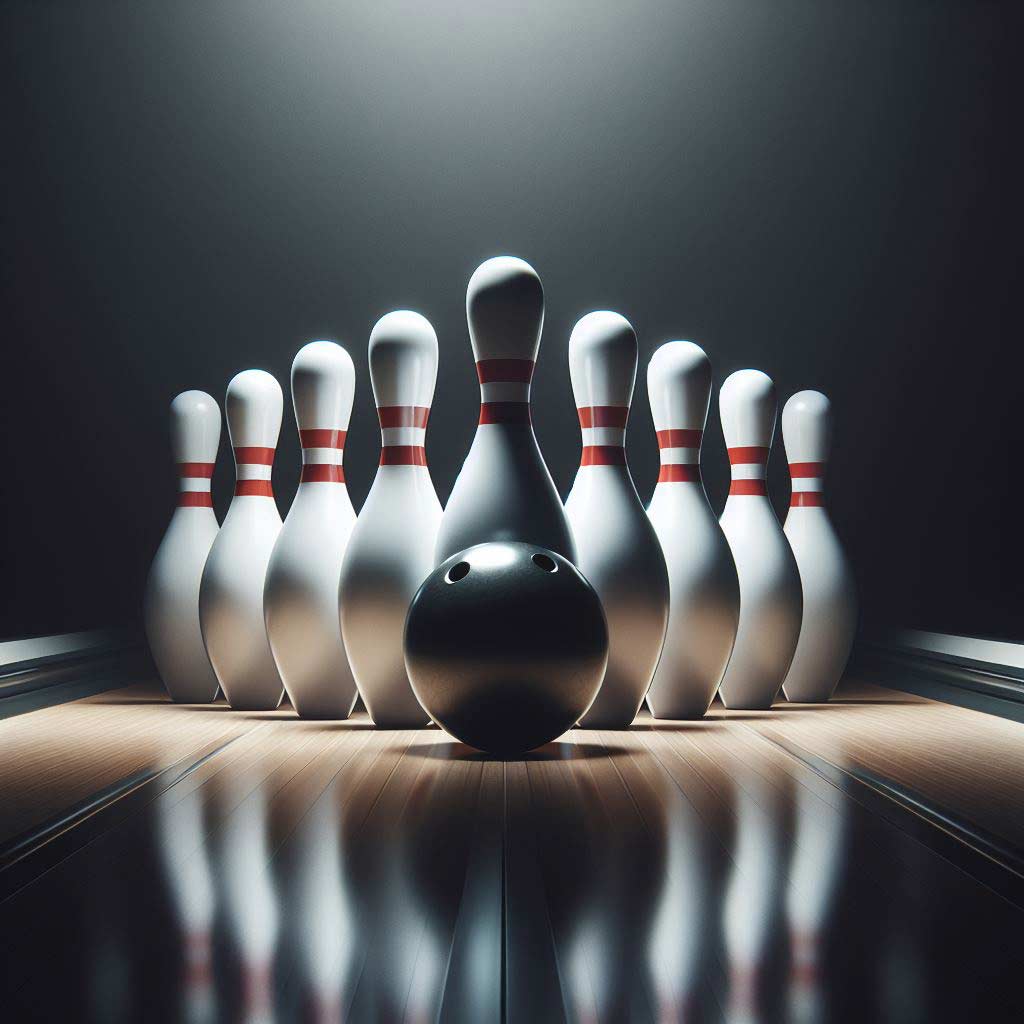If you’re a bowling enthusiast or simply curious about different variations of the sport, you’ve likely come across the term “9 pin bowling.” This distinct form of bowling differs from the traditional 10 pin game in several ways, offering a unique challenge and appeal for players of all skill levels.
In this comprehensive guide, we’ll delve into the fascinating world of 9 pin bowling, exploring its history, rules, techniques, and everything you need to know to appreciate and potentially try out this engaging variation.
What is 9 Pin Bowling?
At its core, 9 pin bowling is a variation of the traditional bowling game that involves knocking down pins arranged in a distinct diamond formation instead of the typical triangular setup used in 10 pin bowling.
While the basic premise remains the same – rolling a ball down a lane to knock down pins – the unique arrangement of the pins and the scoring system set 9 pin bowling apart as a separate discipline.
In 9 pin bowling, the pins are positioned in a diamond shape, with one pin (the “headpin”) at the front, three pins behind it, two pins behind those, and three pins at the back.
This tighter configuration makes achieving strikes (knocking down all nine pins on the first roll) significantly more challenging compared to 10 pin bowling.
History and Origins of 9 Pin Bowling:
The origins of 9 pin bowling can be traced back to the early 20th century in Canada, where it quickly gained popularity as a distinct bowling discipline.
Unlike the more widespread 10 pin bowling, which has its roots in Germany and the United States, 9 pin bowling emerged as a quintessentially Canadian sport.
The first recorded instances of 9 pin bowling date back to the 1900s in the Canadian cities of Toronto and Hamilton. It’s believed that the game evolved from a combination of various bowling variations, including the German “Kegling” and the British “Skittles.” However, the unique diamond-shaped pin arrangement and specific scoring system set 9 pin bowling apart from its predecessors.
Over the years, 9 pin bowling gained a loyal following across Canada, with dedicated bowling alleys and tournaments springing up throughout the country.
While it remains a niche sport globally, it has become an integral part of Canadian sporting culture, with numerous competitive events and dedicated players who appreciate the game’s distinct challenges.
Basic Rules and Gameplay:
At its core, 9 pin bowling follows a similar principle to its 10 pin counterpart – players roll a ball down a lane, aiming to knock down as many pins as possible. However, the distinct pin arrangement and scoring system set 9 pin bowling apart.
In 9 pin bowling, the pins are arranged in a diamond formation, with one pin (the “headpin”) at the front, three pins behind it, two pins behind those, and three pins at the back.
This diamond configuration adds an extra layer of difficulty, as the pins are more tightly clustered, and knocking down all nine pins on the first roll (a “strike”) becomes a rarer feat.
Scoring in 9 pin bowling is also unique. Unlike 10 pin bowling, where a strike awards the player the combined total of the next two rolls, in 9 pin bowling, a strike is worth 15 points, plus any additional pins knocked down on the next two rolls. This scoring system adds an extra layer of strategy, as players must balance the pursuit of strikes with maximizing their overall pin count.
Other key rules and terms in 9 pin bowling include:
- Frames: A game of 9 pin bowling consists of 10 frames, with each player receiving three rolls per frame.
- Open Frame: If a player fails to knock down all nine pins in a frame, it’s called an “open frame.”
- Fouls: Similar to 10 pin bowling, stepping over the foul line or knocking down pins with any part of the body other than the ball results in a foul, nullifying any pins knocked down on that roll.
Equipment and Specifications:
While the basic concept of rolling a ball down a lane remains the same, the equipment and specifications in 9 pin bowling differ slightly from its 10 pin counterpart.
- Bowling Balls: 9 pin bowling balls are typically smaller and lighter than standard 10 pin balls, weighing between 3 and 3.5 pounds (1.36 to 1.59 kg). This lighter weight allows for better control and accuracy when navigating the diamond-shaped pin configuration.
- Lane Dimensions: The lane dimensions in 9 pin bowling are slightly different from 10 pin bowling. The lanes are typically 41.5 inches (105 cm) wide and 60 feet (18.3 m) long, with the pins set 60 feet (18.3 m) from the foul line.
- Bowling Shoes: As with any form of bowling, proper footwear is essential for safety and performance. 9 pin bowling shoes typically feature a smooth sole on one foot and a rubber heel on the other, allowing for a controlled slide during the approach and release.
Techniques and Strategies:
Like any skilled sport, 9 pin bowling requires proper technique and strategic thinking to excel. While the basic principles of stance, approach, and release remain similar to 10 pin bowling, the unique pin configuration in 9 pin bowling demands some adjustments and specialized techniques.
Stance and Approach:
In 9 pin bowling, players often employ a more upright stance and a straighter approach compared to 10 pin bowling. This adjustment helps maintain better control and accuracy when targeting the tightly clustered pins.
Release Techniques:
Due to the diamond-shaped pin arrangement, players in 9 pin bowling often rely on a straighter release, aiming for the headpin or the pocket between the front and back rows. However, more advanced players may also incorporate hook shots or other spin techniques to navigate around the pins more effectively.
Strategic Considerations:
In addition to technical proficiency, 9 pin bowling requires strategic thinking and decision-making. Players must constantly evaluate the pin configuration and determine the best approach to maximize their score. For example, leaving a single pin standing may be preferable to attempting a risky shot that could result in an open frame.
Common strategies in 9 pin bowling include:
- Picking up spares: Knocking down any remaining pins after the first roll is crucial, as open frames can significantly impact your overall score.
- Strike opportunities: While strikes are less common in 9 pin bowling, identifying and capitalizing on strike opportunities can provide a substantial scoring boost.
- Leaving favorable pin configurations: Experienced players may intentionally leave certain pin configurations that offer easier spare opportunities or set up better scoring potential on subsequent rolls.
Variations and Formats:
Like many popular sports, 9 pin bowling has evolved to include various competitive formats and variations, adding to the game’s depth and versatility.
Competitive Formats:
- Singles: The traditional format where individual players compete against one another.
- Doubles: Two players form a team, alternating frames and combining their scores.
- Team Events: Larger teams, often comprised of four to six players, compete against other teams, with each player’s score contributing to the overall team total.
Variations:
- No Tap: In this variation, knocking down nine pins on the first roll automatically awards the player a strike, regardless of the pin configuration.
- Scotch Doubles: A unique format where two players share the same ball, alternating shots within the same frame.
These variations and formats not only cater to different skill levels and preferences but also add an extra layer of excitement and challenge to the game.
Popular Tournaments and Events:
While 9 pin bowling may not enjoy the same global popularity as its 10 pin counterpart, it boasts a dedicated competitive circuit, particularly in Canada, where the sport has a rich tradition.
Some of the most prestigious 9 pin bowling tournaments and events include:
- The Canadian National 9 Pin Championships: Held annually, this event attracts the top 9 pin bowlers from across Canada and features various divisions, including singles, doubles, and team events.
- The Holiday Classic: One of the longest-running and most prestigious 9 pin bowling tournaments, the Holiday Classic has been taking place in Ontario, Canada, since the 1950s.
- Provincial and Regional Championships: Many Canadian provinces and regions host their own 9 pin bowling championships, providing opportunities for local talent to shine and qualify for national events.
These tournaments not only showcase the skill and dedication of top 9 pin bowlers but also offer substantial prize money and recognition within the sport’s community.
9 Pin Bowling vs. 10 Pin Bowling:
While both 9 pin and 10 pin bowling share the fundamental concept of knocking down pins with a ball, there are several key differences that set these variations apart.
Rules and Scoring:
- In 9 pin bowling, pins are arranged in a diamond formation, while 10 pin bowling uses a traditional triangular setup.
- Scoring in 9 pin bowling is based on a strike being worth 15 points, plus any additional pins knocked down on the next two rolls, whereas in 10 pin bowling, a strike awards the player the combined total of the next two rolls.
- 9 pin bowling allows three rolls per frame, while 10 pin bowling limits players to two rolls per frame (unless a strike is achieved).
Equipment:
- 9 pin bowling balls are typically smaller and lighter than standard 10 pin balls, weighing between 3 and 3.5 pounds (1.36 to 1.59 kg).
- Lane dimensions and specifications differ slightly between the two variations.
Challenges and Strategies:
- The diamond-shaped pin configuration in 9 pin bowling makes achieving strikes more challenging, requiring greater accuracy and precision.
- Strategic considerations, such as leaving favorable pin configurations or prioritizing spare conversions, play a more significant role in 9 pin bowling
Skill and Difficulty:
While both variations of bowling require skill and practice, many players and experts consider 9 pin bowling to be more challenging than its 10 pin counterpart. The tighter pin configuration and the rarity of strikes demand a higher level of precision and accuracy from players.
However, the debate over which variation is more difficult often comes down to personal preference and individual strengths. Some players may find the straight-line approach and strategic decision-making in 9 pin bowling more suited to their style, while others may excel at the hook shots and strike opportunities more prevalent in 10 pin bowling.
Ultimately, both variations offer unique challenges and rewards, and the choice between 9 pin and 10 pin bowling often comes down to individual preference, regional popularity, and access to facilities.
Getting Started in 9 Pin Bowling:
If the distinct challenges and appeal of 9 pin bowling have piqued your interest, you may be wondering how to get started in this engaging sport.
While not as widely available as 10 pin bowling alleys, there are still plenty of opportunities to experience 9 pin bowling, especially in Canada and certain regions where it has a strong following.
Finding a 9 Pin Bowling Alley:
The first step is to locate a bowling center or alley that offers 9 pin bowling facilities. In Canada, many traditional bowling alleys have dedicated lanes or sections for 9 pin bowling.
You can search online directories, check with local bowling associations, or inquire at nearby bowling centers to find the nearest 9 pin bowling facilities in your area.
If you’re located outside of Canada or areas with a strong 9 pin bowling presence, your options may be more limited. However, some bowling centers or clubs may offer occasional 9 pin bowling leagues or events, providing an opportunity to try out this unique variation.
Getting the Right Equipment:
While you can typically rent bowling shoes and balls at most bowling alleys, many dedicated 9 pin bowlers prefer to invest in their own equipment. As mentioned earlier, 9 pin bowling balls are smaller and lighter than standard 10 pin balls, weighing between 3 and 3.5 pounds (1.36 to 1.59 kg).
When selecting a 9 pin bowling ball, consider factors such as weight, grip size, and desired hook potential. Many bowling pro shops or specialized retailers can guide you through the process of finding the right ball for your skill level and playing style.
Joining a League or Taking Lessons:
One of the best ways to improve your 9 pin bowling skills and fully immerse yourself in the sport is by joining a local league or taking lessons from experienced coaches or professionals.
Leagues offer a structured environment for regular play, friendly competition, and the opportunity to learn from more experienced bowlers. Many bowling centers offer 9 pin bowling leagues for different skill levels and age groups, catering to both casual and competitive players.
Private or group lessons from certified 9 pin bowling coaches can also be invaluable for beginners and intermediate players looking to refine their techniques, develop strategies, and better understand the nuances of the game.
Embracing the 9 Pin Bowling Community:
As with any niche sport or activity, 9 pin bowling has a dedicated and passionate community of players, enthusiasts, and supporters. Immersing yourself in this community can not only enhance your enjoyment of the game but also provide valuable resources, networking opportunities, and a deeper appreciation for the sport’s rich history and traditions.
Consider joining local or regional 9 pin bowling associations or clubs, attending tournaments or events as a spectator, or connecting with other players through online forums or social media groups. These connections can offer insights, tips, and a sense of camaraderie that can further fuel your passion for 9 pin bowling.
Conclusion:
9 pin bowling may not enjoy the same widespread popularity as its 10 pin counterpart, but it undoubtedly offers a unique and challenging experience for bowling enthusiasts.
With its distinct diamond-shaped pin configuration, strategic scoring system, and dedicated community, 9 pin bowling has carved out a special niche in the world of bowling, particularly in Canada, where it has become an integral part of the sporting culture.
Whether you’re a seasoned bowler looking for a new challenge or a newcomer intrigued by this captivating variation, 9 pin bowling promises an engaging and rewarding experience.
By understanding its history, mastering the techniques and strategies, and immersing yourself in its vibrant community, you can appreciate the nuances and appeal that have made 9 pin bowling a beloved pastime for generations.
So, the next time you visit a bowling alley, consider stepping up to the challenge of 9 pin bowling. Who knows? You might just discover a newfound passion and appreciation for this unique and engaging sport.





